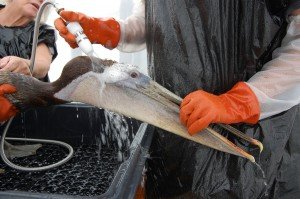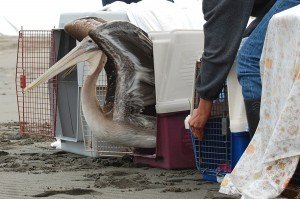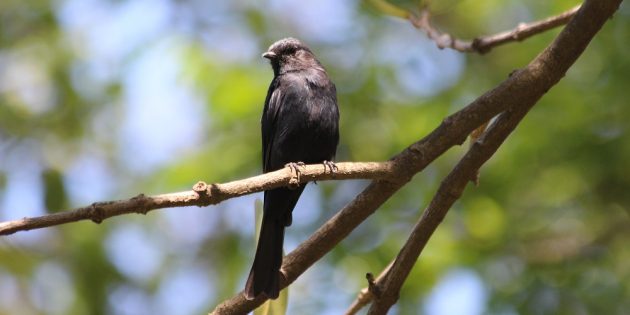
“The young ones are incredibly curious and playful,” says Monte Merrick, the co-Director of Bird Ally X in Arcata, California, which is almost to the border of Oregon. “The adults don’t say much – minor grunts, mostly bill clacking. But the babies bark like dogs and moo like cows.”
He’s talking about Brown Pelicans.
“We always wear safety goggles,” he says. “I once had an adult who grabbed my goggles, yanked them off my head, and threw them across the room. I was really glad I was wearing those goggles.”
Monte has been part of oil-spill rescue teams all over the country. He told me about last summer, when Bird Ally X received 246 Brown Pelicans covered not with petroleum, but with fish oil. The result is the same: feathers are coated, waterproofing is lost, and the birds die from hypothermia and starvation.
Fisherman along California’s Redwood Coast are supposed to use fish-cleaning stations, where they clean their catch on large tables and place the rest in large containers. Both the US Environmental Protection Agency and California state law define fish remains as sewage, and it must be disposed of properly. Naturally, this is not always the case.
Last summer in one marina the fish remains were going into a grinder the size of a VW bus. But instead of being carted away, the oily mess was simply funneled into a large pipe, and then spewed out into the ocean. Pelicans, waiting for a free meal, stood under the pipe and were seriously slimed.
It takes about an hour for a team of three people to painstakingly wash each bird with Dawn dishwashing liquid (a rehabber’s best friend), rinse and dry them. Birds who have been oiled for days or have infections require additional care. They eat like hogs, with 250 pelicans eating hundreds of pounds of smelt a day. Like all rehabbers, Bird Ally X volunteers spend a lot of time asking people for donations.
“The trick with rehabbing any oiled aquatic bird,” says Monte, “is to make sure they feel comfortable enough to preen. We can get the contaminant off their feathers, but from then on they have to do the work.” As a pelican concierge, Monte has come up with tricks such as drilling holes in the sides of plywood hospital boxes and substituting pallets for flooring, all to provide ventilation to compromised birds who might otherwise become overheated.
Besides actually rehabbing, Monte spends a lot of time convincing people that fish waste could be a money-maker and save birds’ lives in the process. Remembering a fourth-grade class where he learned that Massachusetts Native Americans planted fish heads along with their corn, he collected fish waste and composted it. A few months later he put an ad in the local paper describing the resulting soil, and within a few hours every garden club member in town had arrived and the entire 3 ½ yards of compost was gone.
“Pelicans are incredibly cool birds,” he says. “We maintain our distance and try not to engage them at all, because we don’t want them to beg for food from people. But the first time you toss a fish into a pelican’s enclosure, he’ll stare at it, then stare at you, and eventually he’ll walk over and eat the fish. But the second time, he’ll run and catch it in mid-air. I only did it once, then I learned. But I have to say, it was just so much freakin’ fun to play catch with a pelican.”
http://birdallyx.blogspot.com/
https://www.facebook.com/bird.ally.x
Bottom two photos by Bird Ally X














Suz- I love the brown pelicans so much!! they make me happy just watching them fly in squads down the coast…this is a happy story- thank you so much! xoxoxo